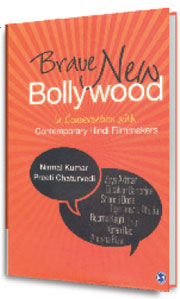 What is the filmmaker’s role in the debate on society influencing cinema or vice versa?
What is the filmmaker’s role in the debate on society influencing cinema or vice versa?
CinemA iS a product of culture. It is also something that contributes to it. Populist cinema, because of its mass appeal, has a strong influence. Indian masses seem to be particularly swayed by movies due to their dependence on the medium to escape from their daily worries, into the world of make-believe. Cinema in India also shapes the cultural, social and political values of the society in more ways than one.
The influence of Hindi films over how we behave, the songs we dance to, the situations that make us laugh and cry, and the construction of popular culture in general is undeniable. Indian cinema is a crucial and unifying socio-cultural factor. It can be seen as one of the most effective mediums of visual communications today. While the medium of films may be escapist, the increasing questioning of cinematic influence on social culture has led to a whole range of discussions on the possibilities of the film medium as such. One of the biggest debates about the social impact of any media can be summarised in one question — does the media have a significant amount of power over its audience, or does the audience have more power than the media?
Ingmar Bergman had once famously said this about his purpose in filmmaking as being “…to illuminate the human soul with an infinitely more vivid light, … and to annex to our field of knowledge new domains of reality….”
At the crux of this debate is also the medium of the filmmaker who brings the thought on screen and conveys it to the audiences. What is his role then in the debate on society influencing cinema or vice versa?
It is through conversations of the authors with various contemporary filmmakers in the book Brave New Bollywood that we can get an insight into the standpoint of eight directors — Zoya Akhtar, Dibakar Banerjee, Shonali Bose, Tigmanshu Dhulia, Reema Kagti, Onir, Kiran Rao and Anusha Rizvi — who chose to swim against the tide and, therefore, influenced a change in the direction of cinematic storytelling in India. Akhtar and Dhulia, who have, for the sake of wanting to make their cinema reach the masses, not stayed away from hiring stars, are the most commercial of the eight.
Besides Satyajit Ray, no other Indian filmmaker has hitherto been able to discuss his craft and the kind of influences that have shaped the film — threadbare. In his 1966 essay, The Odds Against Us, the world-renowned filmmaker had written, “Avantgardism is a luxury we cannot yet afford in our country.” Almost five decades later, there are a handful of directors who are being lauded for their iconoclastic narratives and challenging comfortable representations.
Each of these eight directors, have, seemingly conscientiously, held aloft the torch of radical cinema in a day and age where stereotypes have ruled the roost. The authors, Nirmal Kumar and Preeti Chaturvedi, have been able to draw out the filmmakers to explain their craft and their backgrounds, which “includes their religious beliefs, social moorings and cinematic influences”. Conversations with each reveal their particular brand of cinema, what draws them to it, the social milieu that helped them mature and the struggles of their creative journeys.
Dibakar Banerjee calls his work “anti-dumb cinema”, and his statement sets the mood and tone of the book that seeks a backward journey into the minds of the directors who have almost started a new movement in Hindi cinema where it is good to bring your mind to the movie theatre. “Either you get subverted or you will subvert” is Banerjee’s answer when asked if stars will be allowed to dictate his content.
While stars still sell more than scripts, there is a palpable change in the air. And if more auteur talent continues to join Bollywood’s brave new brigade, soon Indian cinema will be a global influencer, artistically, and not just commercially.
